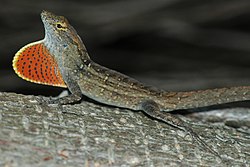![]() Submitted by Cindy Hua for Evolution
Submitted by Cindy Hua for Evolution
Most of us think that evolution in species take several generations to thousands of years to occur. However, how about if I say in one generation’s time there is a significant change in morphology? Jonathan Losos and his team of researchers from Washington University, St. Louis has found a peculiar lizard that is evolving in a tremendous rate. The brown anole, a Caribbean native lizard, spends most of its day hunting on the ground. One of its main predators is the curly-tailed lizard.
 As we all know from our evolution class, a chain of islands sets up a great opportunity for parent species to change significantly. Since the Bahamas are home to the brown anole, natural selection will most likely to occur if there is a change in predator population. Losos has tested his hypothesis that with the introduction of more curly-tailed lizards into the main island, the brown anoles are under the influence of selection pressure change (Losos, et. al, 2006). When brown anoles sense danger of increasing populations of curly-tailed lizards, it flees towards trees and stay away from the ground activities for a few generations.
As we all know from our evolution class, a chain of islands sets up a great opportunity for parent species to change significantly. Since the Bahamas are home to the brown anole, natural selection will most likely to occur if there is a change in predator population. Losos has tested his hypothesis that with the introduction of more curly-tailed lizards into the main island, the brown anoles are under the influence of selection pressure change (Losos, et. al, 2006). When brown anoles sense danger of increasing populations of curly-tailed lizards, it flees towards trees and stay away from the ground activities for a few generations.
After a year’s experiment, Losos discovered that the brown anoles are experiencing a change in leg morphology. In the first six months of his study, the anoles originally had long legs, which enable them to outrun the predators. However, six months later, the survivors had drastically shorter legs, which permit them to hide in narrow crevices and climb in trees. Losos noticed that within a single generation, the anoles went to quick reversals in selection pressure (Losos, et. al). The behavior of the lizards changed, as they prefer treetops than the ground. Here we see natural selection at its finest.
Over several generations down, the continuing threat of curly-tailed lizards will force the anoles population to evolve shorter and shorter legs. However, I find it hard to believe that brown anoles can evolve in one generation at such a fast pace. Perhaps through time the longer legged anoles died off and Losos found mostly shorter legged since it was able to survive and reproduce.
The quick reversal of evolution by means of selection pressure is quite interesting. The brown anoles started with long legs to outrun its predators but discovered it to be a hindrance as it cannot bend its legs to hide in crevices. It preferred to have shorter legs to save energy and it is easier to live in trees away from the main predator. The anoles do not have a use of long legs anymore so it does not have to evolve back. For example, ostriches, emus, and kiwis all are flightless birds yet they have small wings. Their ancestors were flying species, but, through time, with fewer predators to run away from, they probably foraged on the ground more. Over generations, they most likely could adapt better on land and did not need developed wings for flight. That is why they evolved long, strong legs for running and scratching for food. I believe this is similar to what is occurring to the brown anoles. Their ancestors must have evolved longer legs to run away from predators. however, current species reverted to shorter legs when selection pressure changed. Although I believe the leg lengths did change because of pressure, I find it hard to believe this had all occurred in one generation.
Reference:
J. B. Losos, T. W. Schoener, R. B. Langerhans, D. A. Spiller (2006). Rapid Temporal Reversal in Predator-Driven Natural Selection Science, 314 (5802), 1111-1111 DOI: 10.1126/science.1133584













0 comments:
Post a Comment